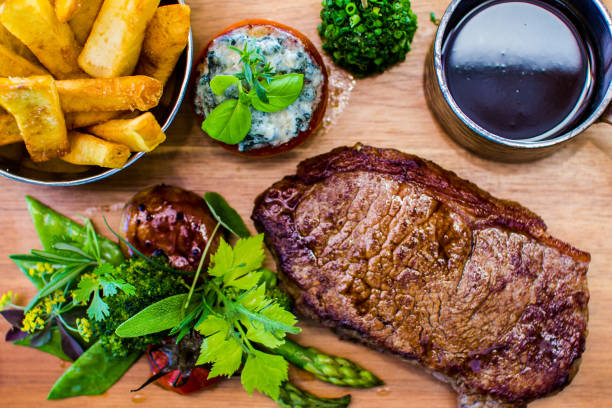A beautifully cooked steak is a work of art, a culinary masterpiece that satisfies the senses and indulges the palate. Achieving the perfect steak requires a blend of skill, patience, and an understanding of the nuances of meat. Whether you prefer it rare, medium-rare, or well-done, there’s an art to cooking steak to perfection.
Selecting the Right Cut
The journey to the perfect steak begins with selecting the right cut. Different cuts offer distinct textures, flavors, and levels of tenderness. Here are some popular steak cuts to consider:
1. Ribeye: Known for its rich marbling and intense beefy flavor, ribeye is a favorite of steak enthusiasts.
2. Filet Mignon: As one of the most tender cuts, filet mignon is prized for its mild, delicate taste.
3. New York Strip: A well-balanced combination of marbling and tenderness makes New York strip a versatile choice.
4. T-Bone and Porterhouse: These cuts offer a unique dining experience by including both the filet and the New York strip, each with its distinct qualities.
Seasoning and Resting
Before you start cooking, allow the steak to come to room temperature, which ensures even cooking. Season the steak generously with kosher salt and freshly ground black pepper. Let it rest for at least 30 minutes, which allows the seasonings to penetrate the meat.
The Right Heat
The secret to a perfectly seared steak is high, direct heat. Whether you’re using a grill, stovetop, or oven, make sure it’s preheated and searing-hot. The initial sear locks in the juices and creates that coveted crust.
Timing and Temperature
Cooking the perfect steak is all about precision. You can use an instant-read meat thermometer to gauge the internal temperature:
- Rare: 120-125°F (49-52°C)
- Medium-Rare: 130-135°F (54-57°C)
- Medium: 140-145°F (60-63°C)
- Medium-Well: 150-155°F (65-68°C)
- Well-Done: 160°F (71°C) and above
Remember that the steak’s internal temperature continues to rise a few degrees after removing it from the heat. Allow for this carryover cooking when gauging the desired doneness.
Flipping and Basting
Contrary to the myth that you should only flip a steak once, flipping it frequently can lead to more even cooking. Basting the steak with melted butter, fresh herbs, and garlic enhances the flavor and keeps it moist.
Resting, Slicing, and Serving
After removing the steak from the heat, allow it to rest for a few minutes. This step is crucial, as it allows the juices to redistribute throughout the meat, resulting in a juicy, flavorful steak. When slicing, cut against the grain to ensure tenderness. Serve your perfectly cooked steak with your choice of sides and garnishes.
Doneness and Variations
1. Rare: A rare steak is seared on the outside but cool and red in the center. It’s incredibly tender, with a burst of beefy flavor.
2. Medium-Rare: A medium-rare steak boasts a warm red center with a slightly firmer texture. It’s the preferred doneness for many steak enthusiasts.
3. Medium: A medium steak features a warm pink center and is less juicy than medium-rare but still enjoyable.
4. Medium-Well: At this stage, the steak is mostly gray with a slightly pink center. It’s a bit firmer and less juicy.
5. Well-Done: Well-done steaks are brown throughout and have a firm, dry texture. While some prefer this level of doneness, it’s essential to avoid overcooking, which can lead to toughness.
Experimentation and Variations
Cooking the perfect steak is not limited to a single approach. Culinary creativity allows for various cooking methods and techniques:
1. Reverse Searing: In this method, you start with low, indirect heat and finish with a high-heat sear. It’s a fantastic way to achieve an evenly cooked steak with a consistent level of doneness.
2. Sous Vide: Sous vide cooking involves vacuum-sealing the steak and cooking it in a water bath at a precise, controlled temperature. Finish by searing it briefly on high heat.
3. Smoking: Smoking steaks adds a unique depth of flavor. Choose hardwoods like hickory or mesquite for a smoky, aromatic profile.
Accompaniments and Garnishes
Enhance your perfect steak with complementary accompaniments and garnishes:
1. Compound Butter: Elevate the flavors with a pat of compound butter, such as garlic and herb, on top of the hot steak.
2. Sauteed Mushrooms: Sautéed mushrooms provide an earthy, umami-rich contrast to the steak.
3. Chimichurri: This vibrant herb sauce with garlic and vinegar adds a zesty kick to the meat.
4. Red Wine Reduction: A reduction sauce made with red wine, shallots, and herbs complements the steak beautifully.
5. Grilled Asparagus: A side of grilled asparagus with a drizzle of olive oil and lemon zest adds freshness to the dish.
The Art of the Perfect Steak
Cooking the perfect steak is a journey of exploration, experimentation, and culinary artistry. It’s a testament to the chef’s skill and a celebration of quality ingredients. Whether you prefer a rare filet mignon, a medium-rare ribeye, or a well-done New York strip, the perfect steak is a canvas for creating an unforgettable dining experience.
